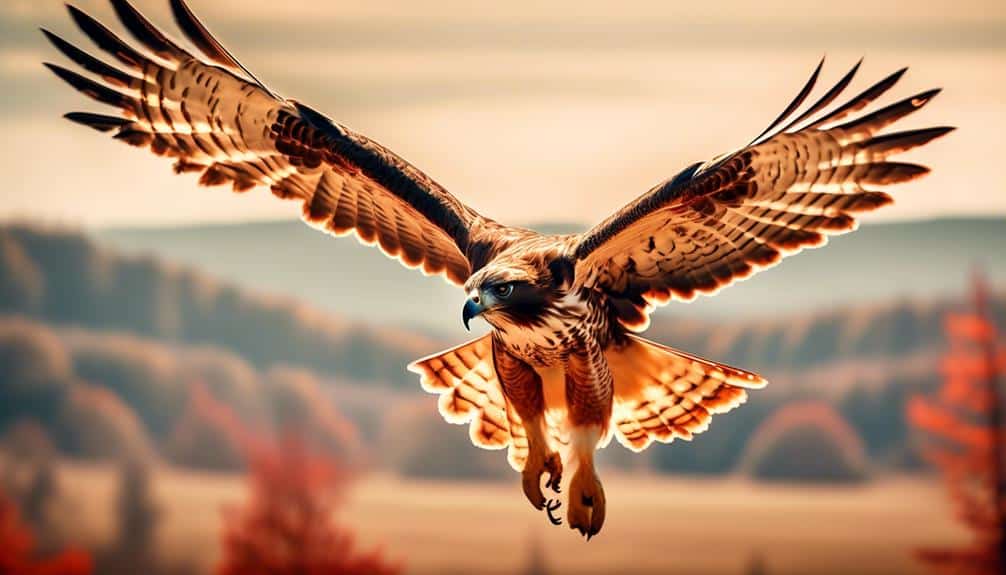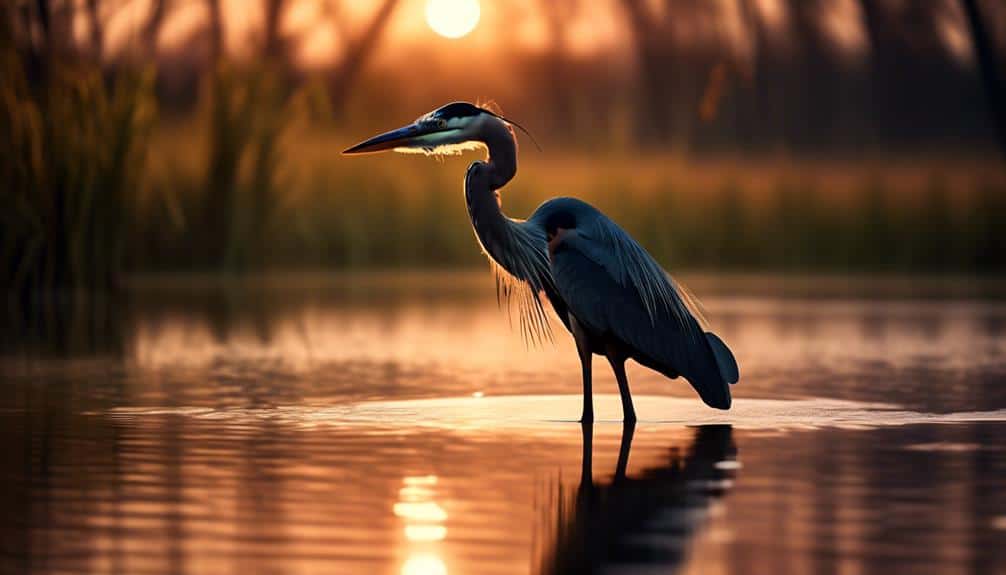Did you know that Ohio is home to a diverse range of large bird species? From majestic Bald Eagles to the soaring Red-tailed Hawks, these magnificent creatures grace the skies of the Buckeye State with their presence.
But it doesn't stop there. Ohio also hosts the graceful Great Blue Heron, the striking American White Pelican, and the elegant Sandhill Crane.
With such an array of impressive avian species, it's no wonder that bird enthusiasts flock to Ohio. So, if you're curious to learn more about these remarkable birds and their habitats, stick around to discover the wonders that await in the skies above Ohio.
Bald Eagle

The Bald Eagle, a majestic bird of prey, is a prominent species found in Ohio. It's known for its striking appearance, with its distinctive white head and tail contrasting against its dark brown body. The bald eagle population in Ohio has seen a significant increase in recent years, thanks to successful conservation efforts.
Bald eagles were once on the brink of extinction due to habitat loss, hunting, and the use of pesticides, which led to a decline in their numbers. However, dedicated conservation initiatives have helped to protect and restore their habitats, leading to a resurgence in the bald eagle population.
Conservation efforts for the bald eagle in Ohio have focused on habitat restoration, protection of nesting sites, and monitoring of populations. The Ohio Department of Natural Resources, along with various wildlife organizations, has implemented measures to ensure the well-being of these magnificent birds.
Through these conservation efforts, the bald eagle population in Ohio has rebounded, with an increasing number of nesting pairs being observed. This success story is a testament to the importance of conservation efforts and the positive impact they can have on threatened species.
The future looks promising for the bald eagle in Ohio, as ongoing efforts continue to protect and preserve their habitats.
Red-tailed Hawk

After exploring the success of the bald eagle conservation efforts in Ohio, it's fascinating to now turn our attention to the red-tailed hawk, a formidable raptor species found in the state. The red-tailed hawk, scientifically known as Buteo jamaicensis, is a large bird of prey that can be identified by its distinctive reddish-brown tail.
Here are some interesting facts about this majestic bird:
- Habitat requirements:
- Red-tailed hawks can be found in a variety of habitats, including forests, grasslands, and even urban areas.
- They prefer open areas with scattered trees or perches, which provide vantage points for hunting.
- Nests are usually built in tall trees or on cliffs, often reusing the same nest year after year.
- Hunting behavior:
- Red-tailed hawks are skilled hunters and primarily feed on small mammals, such as mice, rabbits, and squirrels.
- They employ a sit-and-wait hunting strategy, perched on a high vantage point, patiently scanning the surroundings for prey.
- Once a target is spotted, the hawk will swoop down with incredible speed and accuracy, using its sharp talons to capture its prey.
The red-tailed hawk is a remarkable bird, perfectly adapted to its environment. Its habitat requirements and hunting behavior make it a successful predator in the Ohio ecosystem. Observing these magnificent creatures in action is truly a sight to behold.
Great Blue Heron

One of the most fascinating avian species found in Ohio is the Great Blue Heron, a majestic and graceful wading bird. The Great Blue Heron is commonly seen in wetlands, marshes, and along the shores of lakes and rivers. Its habitat includes both freshwater and saltwater environments, making it a highly adaptable species. With its long legs and neck, the Great Blue Heron is well-suited for wading in shallow waters, where it patiently waits for its prey.
The behavior of the Great Blue Heron is characterized by its solitary nature and stealthy hunting techniques. It primarily feeds on small fish, amphibians, and invertebrates, using its sharp beak to spear its prey. The Great Blue Heron is known for its slow and deliberate movements, making it difficult for its prey to detect its presence.
Conservation efforts have been put in place to protect the Great Blue Heron and its habitat. Wetland preservation and restoration projects, as well as regulations on hunting and fishing, have contributed to the conservation of this species. As a result, the population of Great Blue Herons in Ohio has remained stable in recent years.
American White Pelican

I have observed the American White Pelican, a magnificent and distinctive bird species, in the wetlands and lakes of Ohio. These large birds captivate the attention of bird enthusiasts and nature lovers alike with their impressive wingspan and graceful flight.
Here are some fascinating aspects of the American White Pelican:
- Migration patterns:
- The American White Pelican is known for its remarkable migration patterns, covering vast distances from breeding grounds in the northern United States and Canada to wintering sites in the southern United States and Mexico.
- They typically migrate in large flocks, often traveling in a V-formation to reduce wind resistance and conserve energy during their long journeys.
- Ohio serves as an essential stopover site for these pelicans during their migration, providing them with abundant food and resting areas.
- Habitat conservation efforts:
- Due to their reliance on wetland habitats, American White Pelicans are highly affected by habitat loss and degradation.
- Conservation organizations and agencies in Ohio have been actively working to protect and restore wetland areas, recognizing the importance of these habitats for the survival of the American White Pelican and other species.
- Efforts include wetland restoration projects, reducing pollution and human disturbances, and establishing protected areas to ensure the long-term survival of these magnificent birds.
Sandhill Crane

Having examined the American White Pelican, a remarkable bird species found in Ohio, we now turn our attention to the Sandhill Crane, a majestic and distinctively large bird that also inhabits the wetlands and lakes of this region.
The Sandhill Crane (Grus canadensis) is a migratory bird with a wingspan of up to 7 feet and a height of 3 to 4 feet. Its gray plumage and red forehead patch make it easily recognizable. These cranes have a unique vocalization, which is often described as a loud and distinctive trumpeting call.
Migration patterns of the Sandhill Crane are fascinating. They breed in the northern parts of North America, including Alaska and Canada, and then migrate to the southern United States for the winter. Some Sandhill Cranes even travel further south to Mexico and Cuba. These migratory journeys can span thousands of miles.
Conservation efforts are crucial to protect the Sandhill Crane population. Loss of habitat due to urbanization and agriculture, as well as hunting, pose significant threats to this species. Several organizations, such as the International Crane Foundation and the U.S. Fish and Wildlife Service, work tirelessly to conserve and manage Sandhill Crane populations. Efforts include habitat restoration, reintroduction programs, and public education campaigns.
Frequently Asked Questions
What Is the Average Wingspan of a Bald Eagle in Ohio?
The average wingspan of a bald eagle in Ohio is approximately 6 to 7 feet. The population of bald eagles has been steadily increasing thanks to conservation efforts, ensuring their continued presence in the state.
How Many Nests of Red-Tailed Hawks Are Typically Found in Ohio During Breeding Season?
During the breeding season in Ohio, it is fascinating to observe the nesting behavior of red-tailed hawks. Their population trends suggest that multiple nests can be found, but the exact number varies.
What Is the Preferred Habitat of the Great Blue Heron in Ohio?
The great blue heron, a large bird found in Ohio, prefers to nest in tall trees near bodies of water, such as lakes or rivers. It feeds on a diet of fish, frogs, and small mammals.
How Many American White Pelicans Can Be Spotted in Ohio During Their Migration Period?
How many American white pelicans migrate to Ohio? Their numbers vary depending on factors like climate change and conservation efforts. Let's explore the impact of these factors on the pelicans' migration patterns and their habitat.
What Is the Primary Diet of Sandhill Cranes in Ohio?
Sandhill cranes in Ohio primarily feed on insects, small mammals, amphibians, and plants. They display opportunistic feeding behavior and adjust their diets based on seasonal availability. During migration, they rely on agricultural fields for sustenance.
Conclusion
As the sun sets on the vast Ohio skies, the majestic wings of these large birds paint a breathtaking allegory of freedom and resilience. The Bald Eagle soars with unwavering determination, embodying the spirit of a nation.
The Red-tailed Hawk, with its piercing gaze, symbolizes the fierce perseverance to overcome any challenge.
The Great Blue Heron, elegant and poised, reflects the harmony and balance of nature.
The American White Pelican and Sandhill Crane unite in graceful flight, reminding us of the power of unity.
These magnificent creatures remind us to embrace the beauty and strength that lies within us all.





